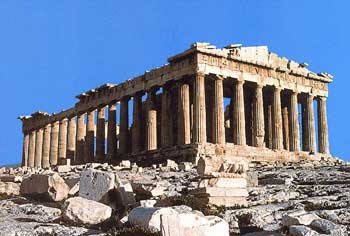The Parthenon was once a masterpiece of color
 If the ancient Greeks sold postcards to tourists 2,000 years ago, they had colorful pictures depicting various views of this famous historical site.
If the ancient Greeks sold postcards to tourists 2,000 years ago, they had colorful pictures depicting various views of this famous historical site.
Archaeologists say a lot of ruins are now different from the original. Many colorful painted parts have faded away with time. They believed that the Parthenon shrine in Athens was covered in bright colors.
It has long been known that this magnificent marble shrine, located on the top of the Athens castle, was painted. New tests conducted by Greek archaeologist and chemical engineer Evi Papakonstantinou-Zioti also confirm that the ancients used bright colors such as red, green and blue.
Traces of these colors were found during the ongoing restoration at the temple built in 432 BC.
The weather simply made the colors fade over time, said Sara Orel, assistant professor of art history at Truman University in Missouri.
" The sunshine, sandy wind and the damage caused by the pollution of today are the main culprits, " Orel said. This phenomenon is also found in works of art on most ancient works in Egypt, they are painted in color to stand out on white stone. Today, these colors are almost invisible.
Part of the most sophisticated carvings of the Parthenon is currently on a special design part of the British Museum in London. The work, named Elgin Marbles, may have been stripped of some colors for aesthetic reasons when it arrived in London in the early 19th century.
In particular, a restoration in the 1930s seriously damaged the color of the work. A historian at Cambridge University accused museum staff of using metal tools to do the job. The problem is that the museum staff had a common mindset like everyone else: the carvings were originally white.
However, Ian Jenkins, in an article published by the British Museum in 2001, objected to the accusation of the 1930 restoration work that turned the Elgin Marbles from colorful color schemes into white paint by day. now on.
" I think when the carvings were taken to the Museum, less than 20% of the surface retained its paint ," Jenkins wrote. " The weather itself is the most important factor that brings the surface and color of the work as we see it today ."
MT
- The mysterious fate of the masterpiece of the artist Caravaggio
- 'Ghost' masterpiece suddenly appeared in the middle of the wilderness thanks to the summer sun
- Illness hidden in famous art masterpiece
- The mystery of Leonardo Da Vinci's lost masterpiece
- Why do human eyes have different colors?
- History of color photography, from dreams to reality
- The relationship between medicine and color
- Screen development is based on the color change of ink
- Interesting differences between how to describe colors in English and Chinese
- Van Gogh's classic picture contains a mystery that no one knows
- 8 sculptural masterpieces that contain little-known secrets
- The color of the shell changes color to the body
 Discovered an ancient centipede fossil 99 million years old
Discovered an ancient centipede fossil 99 million years old Discovered bat-like dinosaurs in China
Discovered bat-like dinosaurs in China Discovered a 200-year-old bronze cannon of the coast
Discovered a 200-year-old bronze cannon of the coast Discover 305 million-year-old spider fossils
Discover 305 million-year-old spider fossils